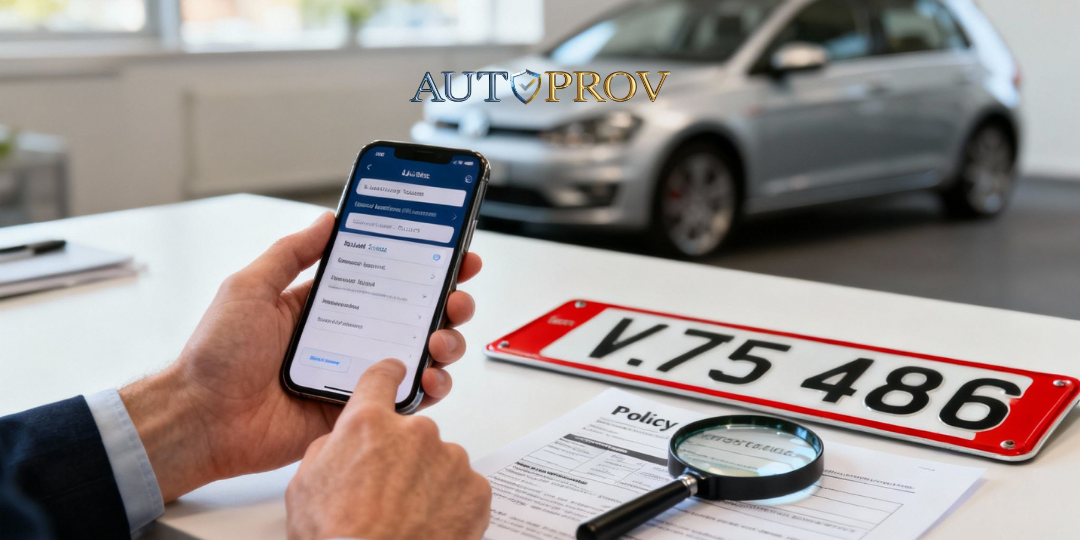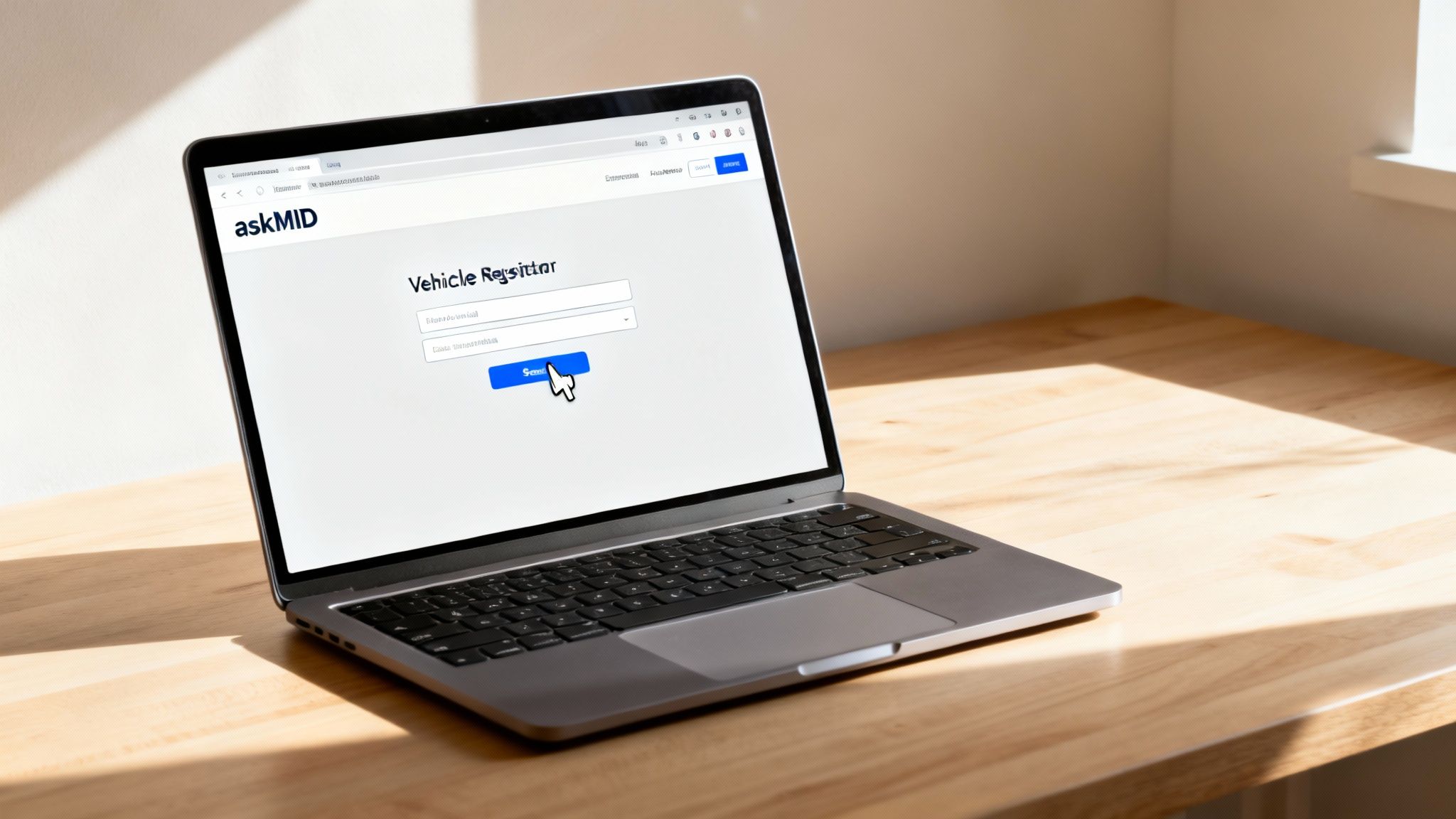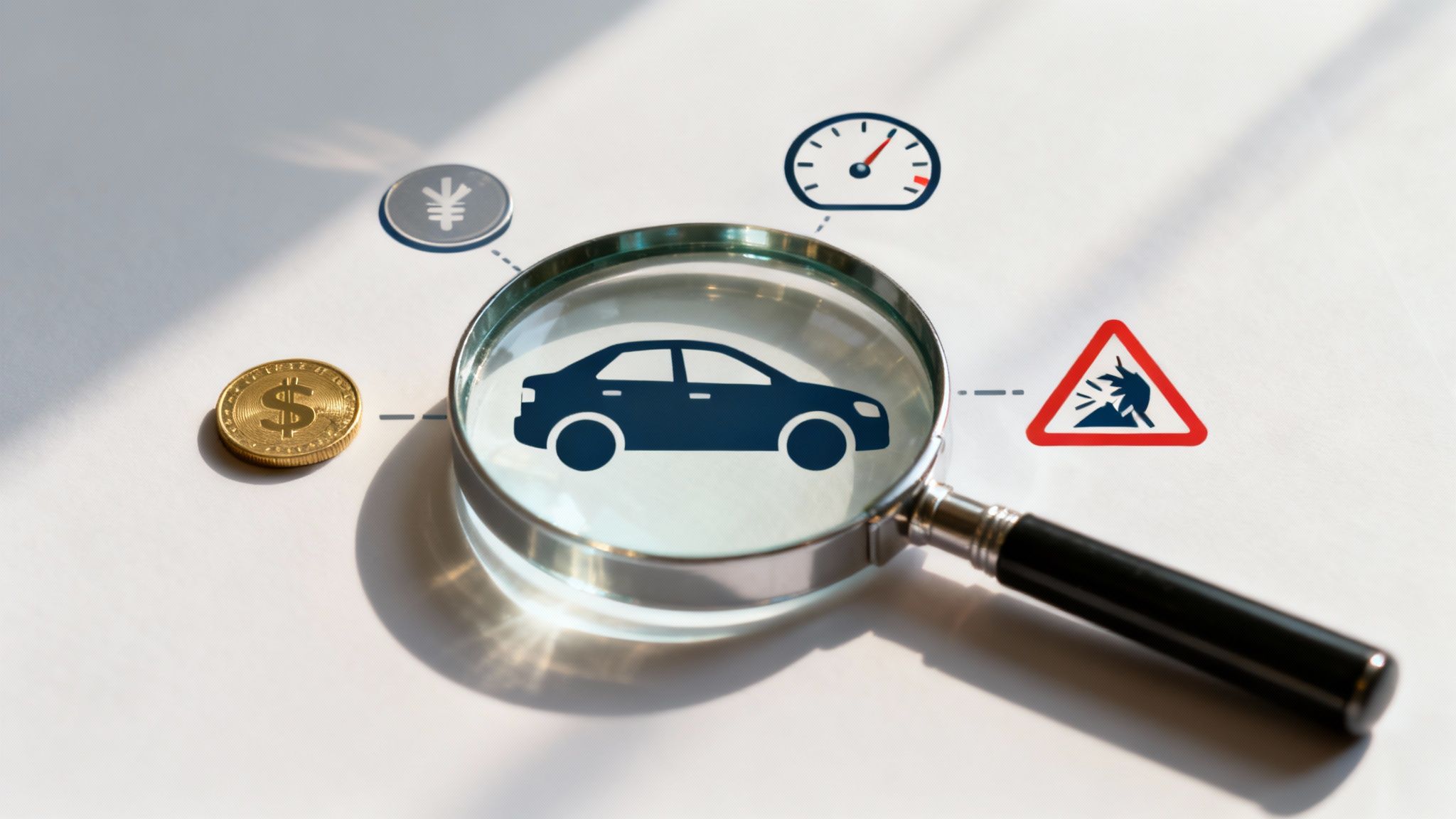
The quickest and most reliable way to check if a car is insured is by using the Motor Insurance Database (MID) online. All it takes is the vehicle's registration number to see if a valid insurance policy is on record. Remember, driving without at least third-party insurance is a serious offence here in the UK.
The quickest and most reliable way to check if a car is insured is by using the Motor Insurance Database (MID) online. All it takes is the vehicle's registration number to see if a valid insurance policy is on record. Remember, driving without at least third-party insurance is a serious offence here in the UK.
Why You Must Check a Car's Insurance Status

Whether you're about to buy a used car or you've just been in a minor shunt, confirming a vehicle's insurance status is a non-negotiable step. Driving an uninsured car in the UK isn't a simple oversight—it’s a major offence with some pretty severe legal and financial repercussions.
Picture this: you're buying a car privately. The seller swears it’s fully insured for you to take it on a test drive. But is it really? If you get pulled over and it turns out it’s not, you could be the one facing fines and points on your licence.
Or consider a more common scenario—you're involved in a collision. If the other driver is uninsured, the claims process can quickly turn into a frustrating, drawn-out, and often expensive nightmare. A quick check gives you instant peace of mind and a layer of protection.
Verifying a car's insurance status is your first line of defence in responsible vehicle ownership and purchasing. It helps you avoid legal trouble, financial loss, and the stress of dealing with uninsured drivers.
The Financial and Legal Stakes
The current financial climate for motorists makes this check more important than ever. While comprehensive car insurance premiums have thankfully dropped by 16% (£136) over the past year to an average of £735, it’s still a hefty expense. You can get more detail on recent premium trends from WTW.
This economic pressure unfortunately tempts some drivers to risk it and go without cover, making verification essential for the rest of us on the road.
Make no mistake, the penalties for being caught without insurance are severe. The consequences can include:
- A fixed penalty of £300 and 6 penalty points on your licence.
- The potential for an unlimited fine if the case goes to court.
- Possible disqualification from driving altogether.
- The police also have the power to seize and, in some cases, even destroy an uninsured vehicle.
For anyone in the motor trade, these risks are amplified. Bringing a vehicle into your stock without valid insurance creates immediate logistical headaches and legal liability. This is precisely why trade-specific platforms like AutoProv build these essential checks right into their system, giving you a complete picture of a car's history for total confidence before you commit to a deal.
Using the MID for an Instant Insurance Check
When you need to know if a car is insured, the most direct and official route in the UK is the Motor Insurance Database (MID). This is the central record that every UK motor insurer feeds into, and it's the very same database the police use to enforce insurance laws on the road. For public access, the go-to portal is the askMID website.
The great thing about it is its simplicity. You just need the vehicle's registration number. Punch that in, and the system gives you a clear, immediate yes or no. It’s a real-time check confirming if a valid insurance policy is currently active for that specific vehicle.
Here’s a look at the askMID homepage, where you can run this free check yourself.

As you can see, the interface is incredibly straightforward. It's built for one single purpose: getting a quick answer from a registration plate. This clean design means anyone can use it without getting bogged down, making it a fantastic tool for a quick spot-check.
Interpreting the Results
Once you submit the registration, you’ll get one of two possible responses:
- "Yes, this vehicle is showing as insured": This is the confirmation you’re after. It means the car has a current insurance policy logged in the national database.
- "No, this vehicle is not showing as insured": This result flags that, according to the MID's records, there is no active insurance policy for the vehicle.
It’s worth keeping in mind that there can be a slight lag. A brand new policy or a recent renewal might take 24-48 hours to show up on the database. While the MID is updated constantly by insurers, the process isn’t always instantaneous.
For motor trade professionals, a basic insurance check is often just the first step. While essential, it doesn’t tell the whole story. That's where platforms like AutoProv come in. They pull together multiple critical data sources, giving you a comprehensive vehicle history that goes far beyond the MID to include outstanding finance, theft reports, and write-off records. It's about getting the full picture you need to trade with absolute confidence.
What To Do When the MID Says a Car Isn’t Insured

So you've checked the Motor Insurance Database (MID), and the result is a bit of a shocker: it’s showing the vehicle has no insurance. Your first reaction might be alarm, especially if you have every reason to believe a valid policy is in place.
Don't panic just yet. This happens more often than you might think. A "no insurance" result isn't always proof of an uninsured driver; quite often, it's just a simple case of timing or a minor administrative hiccup.
The MID Update Lag is a Common Culprit
More often than not, the reason for a 'no' result on a recently insured car is the delay in updating the database. Insurers are constantly feeding new policy information to the MID, but the system isn't always updated in real-time.
Typically, it can take 24 to 48 hours for a brand-new policy, a renewal, or even a change of vehicle on an existing policy to show up. If the cover was arranged over a weekend or a bank holiday, this delay can stretch out even further.
Before you jump to conclusions, the first logical step is to account for this lag. If the policy was only put in place in the last two days, the MID probably just hasn't caught up.
When It's Time to Investigate Further
If a couple of days have passed and the MID is still showing no cover, then it’s probably time to do a little digging. It still doesn't mean there's a definite problem, but it’s certainly wise to follow up.
What you do next really depends on your connection to the vehicle:
- You're the owner: Get in touch with your insurance broker or the provider directly. Just ask them to confirm your policy is active and check that they've correctly submitted the details to the MID. It could be a simple typo on their end.
- You're a potential buyer: This is a bit more delicate. Politely ask the seller to show you some proof of insurance, like a cover note or the policy certificate. Explain what the MID check showed and give them a chance to clear it up with their insurer.
For anyone in the motor trade, an unclear MID result can bring a promising deal to a grinding halt. While a comprehensive platform like AutoProv delivers deep vehicle intelligence, the quickest way to solve a direct insurance query is by talking to the owner. It’s the clearest path to resolving these discrepancies and moving forward with confidence.
When You Need More Than an Insurance Check

Confirming a car's insurance is a crucial first step, but for anyone looking to buy, it’s really just the tip of the iceberg. A positive result from the Motor Insurance Database (MID) simply tells you the vehicle is legally allowed on the road today. It reveals absolutely nothing about its past or its true value as an investment.
The MID won't warn you if a vehicle has outstanding finance, meaning you could buy a car that a lender could repossess at any moment. It won't tell you if it has been declared a write-off by a previous insurer, or if it has suspicious mileage discrepancies that point to clocking. These are the hidden, costly secrets that a basic insurance check will never uncover. This is where you need to look deeper.
Going Beyond the Basic Check
The UK's motor insurance market is incredibly active, which just goes to show how many incidents happen on our roads. In just one quarter, insurers settled 669,000 claims—a 5% jump from the previous period. While tools like the MID help manage this volume, these figures underscore a simple fact: a lot of vehicles have a complex history. You can find more details on these insurance market trends from the Association of British Insurers.
For a potential buyer, this is exactly why a professional vehicle history check is so indispensable. It’s the difference between a simple query and genuine due diligence. You need the complete picture to avoid inheriting someone else’s problems.
A car being insured is not the same as it being a sound purchase. A comprehensive history check protects your investment by uncovering hidden issues that could cost you thousands down the line.
An advanced vehicle intelligence report from a service like AutoProv pulls together all these critical data points into a single, easy-to-read summary. Instead of just seeing an insurance status, you gain access to a full dossier on the vehicle. This report can uncover crucial details such as:
- Finance Agreements: Check for any outstanding loans tied to the vehicle.
- Write-Off History: See if it has ever been categorised as salvage (e.g., Cat S, Cat N).
- Mileage Records: Identify potential clocking by comparing historical data.
- Stolen Vehicle Status: Confirm it isn’t listed on the Police National Computer.
This level of detail moves you from simply checking if a car is insured to confidently knowing it’s a safe and wise purchase for the future.
Checking Your Own Vehicle's Insurance Status
It’s an easy mistake to make. Life gets busy, and suddenly you can’t remember if your insurance renewal went through, or where you put the policy documents. A quick check on your own car is a simple way to get some peace of mind and make sure you’re not accidentally driving uninsured.
There are plenty of reasons to do a quick personal check. Maybe you’ve just switched insurers and want to be certain the Motor Insurance Database (MID) has been updated. Or perhaps you’re worried a missed payment or a simple admin error has left you without cover when you thought you had it.
A two-minute search on askMID is all it takes to confirm your policy is active and officially on the books. Think of it as a crucial part of responsible car ownership—it could save you from an unexpected Fixed Penalty Notice or worse if you get pulled over.
Why Double-Checking Matters
Here’s the thing: an out-of-date or incorrect record on the MID can cause some serious headaches. If an Automatic Number Plate Recognition (ANPR) camera flags your car as uninsured, even if it's just down to a database lag, it can trigger a police stop. Trying to prove you have cover on the side of the road is a stressful situation you can easily avoid.
Getting into the habit of checking your status after any policy change gives you confidence that the official record is correct. For those in the motor trade juggling multiple vehicles, this becomes even more critical. Regularly verifying the insurance on your stock is non-negotiable. Using a platform like AutoProv, which bundles all this data into one place, is a smart way to streamline these checks and ensure every car on the forecourt is compliant and ready for a test drive.
Got Questions About Car Insurance Checks? We've Got Answers
When you're trying to figure out if a car is insured, a few questions always seem to pop up. Whether you're a private buyer doing your homework or a motor trade pro, getting these details straight makes the whole process a lot less of a headache.
How Quickly Does a New Policy Show on the MID?
There’s nearly always a bit of a delay between an insurer green-lighting a policy and it appearing on the Motor Insurance Database (MID). You should expect to wait anywhere between 24 and 48 hours.
Keep in mind, though, if a policy is bought over a weekend or a bank holiday, this can stretch out a bit longer. This lag is the number one reason a car that's just been insured might still flag as uninsured on an askMID check.
Is It Legal to Check Any Car’s Insurance Status?
Yes, it's perfectly legal to check the insurance status of any vehicle using its registration number. The key is that you must have a legitimate reason for doing it, which is why the askMID service is available to the public in the first place.
Legitimate reasons for checking include:
- Checking a car you’re about to buy.
- Verifying insurance details after a road traffic incident.
- Doing a quick check to make sure your own policy has registered correctly.
You’re only confirming that a policy exists; you're not prying into any personal data about the owner.
What’s the Damage for Driving Uninsured in the UK?
The penalties for driving without valid insurance are no joke, and they can escalate very quickly. The police have the power to hand you a fixed penalty of £300 and 6 penalty points right there on the roadside.
If the matter goes to court, you could be looking at an unlimited fine and even a driving ban. On top of that, the police can seize the uninsured vehicle and, in some cases, have it destroyed.
A full vehicle history check is non-negotiable for proper due diligence. It gives you the critical stuff like outstanding finance and write-off history, but for data protection reasons, it can't legally tell you the specific insurer or policyholder's name.
For professionals in the motor trade who need the deepest possible dive into a vehicle's background, a service like AutoProv is the way to go. While it won't name the insurer, it pulls together over 40 other critical data points. It gives you that complete picture you need to trade with absolute confidence.
Frequently Asked Questions
AI-Generated Content Notice
This article was created with the assistance of artificial intelligence technology. While we strive for accuracy, the information provided should be considered for general informational purposes only and should not be relied upon as professional automotive, legal, or financial advice. We recommend verifying any information with qualified professionals or official sources before making important decisions. AutoProv accepts no liability for any consequences resulting from the use of this information.
Published by AutoProv
Your trusted source for vehicle intelligence

